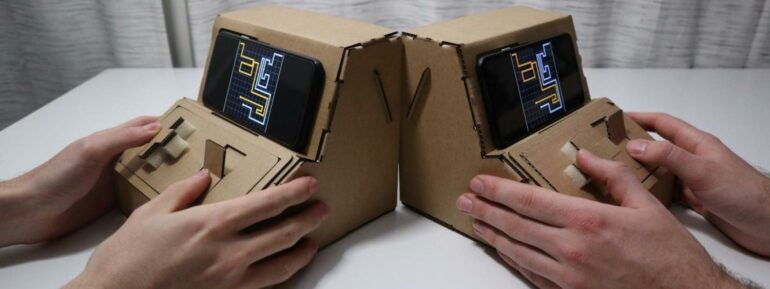Like many people across Colorado, Peter Gyory spent the height of the COVID-19 pandemic sitting at home with nothing to do. Then the researcher, a game designer by training, noticed all the random materials he had lying around his house.
“I was really frustrated that I couldn’t make games,” said Gyory, a doctoral student at CU Boulder’s ATLAS Institute. “I realized I was surrounded by cardboard. I thought: ‘How could I make a game out of that?'”
That was the birth of Tinycade. This project, the brainchild of Gyory and his colleagues at ATLAS, brings a do-it-yourself spirit to the world of video games. Tinycade allows anyone, anywhere to make a working arcade machine that can fit on a kitchen table or even a TV tray. All you need are a smartphone, some cardboard, two small mirrors and bric-a-brac like rubber bands and toothpicks. In other words: junk.
“The restriction I gave myself was that if you couldn’t go to the grocery store and buy it, I couldn’t use it in Tinycade,” Gyory said.
He presented his team’s invention last month at the Association for Computing Machinery’s conference on Creativity & Cognition in Venice, Italy.
Gyory and his colleagues still need to work through some kinks, but he invites interested gamers to connect to beta test the platform. Currently, he’s developing a series of initial games for Tinycade. They include Claw, a spin on the arcade classic game Space Invaders, and De Volta, a game that’s like “playing golf with a spaceship” that he designed with Enric Llagostera at Concordia University in Canada.
The team, however, hopes that one day the platform will allow players to come up with their own, never-before-seen ways for humans to immerse themselves in the digital world
“When Peter and I go to conferences, he would show off all these different kinds of games: games where you’re riding a horse, fighting on a pirate ship,” said Ellen Do, one of the team members behind Tinycade and a professor at ATLAS and the Department of Computer Science. “Why should you have to use a standard keyboard interface for all of those games?”
Creative machines
It’s a theme for Do’s research group, which calls itself the ACME Lab—an allusion to the fictional cartoon company that makes everything from earthquake pills to dehydrated boulders.
“We make machines that help people be more creative,” Do said.
Previously, Gyory and fellow doctoral student Clemet Zheng worked together to design a game called Hot Swap. In this video game, two players team up to pilot a pirate ship through dangerous waters—the twist is that players have to rapidly swap between a series of plastic controllers to stay afloat. A crank lowers the sails, a captain’s wheel makes the ship turn and a set of switches loads and fires the cannons.
“We wanted people to feel like they were fiddling around with the controller, and maybe even losing pieces in the process,” Gyory said.
Space invading
Tinycade takes that tactile, DIY energy to a new level.
Once the platform rolls out, gamers will only need to follow a few simple steps: First, you will download a set of stencils that will help you to cut out and assemble an arcade machine from spare cardboard. You then plop your phone in to serve as the screen.
The machine’s controllers are also made out of cardboard and can be configured into a wide range of designs—from standard video game D-pads and joysticks to knobs, sliders, switches and much more. Within a Tinycade platform are a set of mirrors that allow your smartphone’s camera to see what’s going on under those controls. If you press right on the D-pad, say, the pieces will shift to reveal a digital “marker,” which looks like simple QR code. Your phone will spot that marker, then tell the character on screen to move right.
“I would take the platform to conferences and lift out the controller to show what was inside,” Gyory said. “There was always this moment of realization that I loved where people would see how it worked.”
In the game Claw, which Gyory designed himself, players have to fight off a horde of oncoming alien ships. You slide around a cardboard claw, then pinch when you want to reach out and grab one of the enemy craft with a hook.
The team, however, has a more ambitious vision for Tinycade: Gyory and his colleagues hope that users will soon be able to use the platform to make new types of controllers for any game they can think of.
“Once this system is in place, we want players to be able to say, ‘Here’s Pacman. Let’s make a new controller to move Pacman around,'” he said.
Best of all, no quarters are required.
More information:
Peter Gyory et al, Build Your Own Arcade Machine with Tinycade, Creativity and Cognition (2022). DOI: 10.1145/3527927.3533023
Provided by
University of Colorado at Boulder
Citation:
How to turn throwaway cardboard into a DIY arcade game (2022, July 20)



